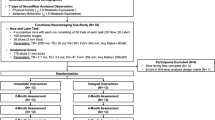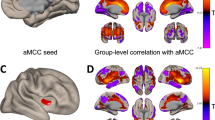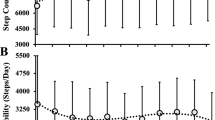Abstract
Background/objectives
To assess the relationships between daily sedentary time (ST), prolonged ST, moderate-to-vigorous physical activity (MVPA), and behavioral and neuroelectric indices of cognitive control in adults with overweight and obesity (OW/OB).
Subjects/methods
A cross-sectional design was used. Overall, 89 adults (BMI = 31.9 ± 4.9 kg/m2) provided measures of ST, prolonged ST (i.e., ST accumulated in ≥20 min), and MVPA from a hip-worn accelerometer worn over 7 days. Inhibitory control was measured with a modified Eriksen flanker task and cognitive flexibility with task switching. The amplitude and the latency of the P3 component of event-related potentials during each task were used as measures of attentional resource allocation and information processing speed, respectively.
Results
After adjusting for ST and MVPA, prolonged ST was related to greater interference (i.e., a larger decrement in accuracy between congruent and incongruent trials of the flanker task) indicative of a specific relationship between prolonged ST and poorer inhibitory control. Before adjusting for ST, MVPA was related to a smaller Global Switch Cost expressed as larger (more positive) amplitude of the P3 difference wave (mixed-task minus single-task condition of the switch task). Adjustment for ST attenuated this association to non-significance.
Conclusions
Our findings suggest that future interventions focused on improving inhibitory control in adults with OW/OB should target restructuring ST in addition to current efforts to increase MVPA.
This is a preview of subscription content, access via your institution
Access options
Subscribe to this journal
Receive 12 print issues and online access
$259.00 per year
only $21.58 per issue
Buy this article
- Purchase on Springer Link
- Instant access to full article PDF
Prices may be subject to local taxes which are calculated during checkout



Similar content being viewed by others
References
Yang Y, Shields GS, Guo C, Liu Y. Executive function performance in obesity and overweight individuals: a meta-analysis and review. Neurosci Biobehav Rev. 2018;84:225–44.
Diamond A. Executive functions. Annu Rev Psychol. 2013;64:135–68.
Erickson KI, Hillman C, Stillman CM, Ballard RM, Bloodgood B, Conroy DE, et al. Physical activity, cognition, and brain outcomes: a review of the 2018 Physical Activity Guidelines. Med Sci Sports Exerc. 2019;51:1242–51.
Oberlin LE, Verstynen TD, Burzynska AZ, Voss MW, Prakash RS, Chaddock-Heyman L, et al. White matter microstructure mediates the relationship between cardiorespiratory fitness and spatial working memory in older adults. Neuroimage. 2016;131:91–101.
Yang L, Cao C, Kantor ED, Nguyen LH, Zheng X, Park Y, et al. Trends in sedentary behavior among the US population, 2001-2016. JAMA. 2019;321:1587.
Napoli N, Shah K, Waters DL, Sinacore DR, Qualls C, Villareal DT. Effect of weight loss, exercise, or both on cognition and quality of life in obese older adults. Am J Clin Nutr. 2014;100:189–98.
Baumgartner NW, Walk AM, Edwards CG, Covello AR, Chojnacki MR, Reeser GE, et al. Relationship between physical activity, adiposity, and attentional inhibition. J Phys Act Health. 2018;15:191–6.
Ku P-W, Liu Y-T, Lo M-K, Chen L-J, Stubbs B. Higher levels of objectively measured sedentary behavior is associated with worse cognitive ability: two-year follow-up study in community-dwelling older adults. Exp Gerontol. 2017;99:110–4.
Tremblay MS, Aubert S, Barnes JD, Saunders TJ, Carson V, Latimer-Cheung AE, et al. Sedentary Behavior Research Network (SBRN) – Terminology Consensus Project process and outcome. Int J Behav Nutr Phys Act. 2017;14:75.
Piercy KL, Troiano RP, Ballard RM, Carlson SA, Fulton JE, Galuska DA, et al. The physical activity guidelines for Americans. JAMA. 2018;320:2020.
Hadgraft NT, Winkler E, Climie RE, Grace MS, Romero L, Owen N, et al. Effects of sedentary behaviour interventions on biomarkers of cardiometabolic risk in adults: systematic review with meta-analyses. Br J Sports Med. 2020. https://doi.org/10.1136/bjsports-2019-101154.
Ekelund U, Tarp J, Steene-Johannessen J, Hansen BH, Jefferis B, Fagerland MW, et al. Dose-response associations between accelerometry measured physical activity and sedentary time and all cause mortality: systematic review and harmonised meta-analysis. BMJ. 2019;366:l4570.
Mora-Gonzalez J, Esteban-Cornejo I, Solis-Urra P, Migueles JH, Cadenas-Sanchez C, Molina-Garcia P, et al. Fitness, physical activity, sedentary time, inhibitory control, and neuroelectric activity in children with overweight or obesity: the ActiveBrains project. Psychophysiology. 2020;57:e13579.
Steene-Johannessen J, Hansen BH, Dalene KE, Kolle E, Northstone K, Møller NC, et al. Variations in accelerometry measured physical activity and sedentary time across Europe - harmonized analyses of 47,497 children and adolescents. Int J Behav Nutr Phys Act. 2020;17:38.
Cooper AR, Goodman A, Page AS, Sherar LB, Esliger DW, van Sluijs EMF, et al. Objectively measured physical activity and sedentary time in youth: the International children’s accelerometry database (ICAD). Int J Behav Nutr Phys Act. 2015;12:113.
Nichols G, Horberg M, Koebnick C, Young D, Waitzfelder B, Sherwood N, et al. Cardiometabolic risk factors among 1.3 million adults with overweight or obesity, but not diabetes, in 10 geographically diverse regions of the United States, 2012–2013. Prev Chronic Dis. 2017;14:160438.
Chung ST, Onuzuruike AU, Magge SN. Cardiometabolic risk in obese children. Ann N Y Acad Sci. 2018;1411:166–83.
Lipnicki DM, Makkar SR, Crawford JD, Thalamuthu A, Kochan NA, Lima-Costa MF, et al. Determinants of cognitive performance and decline in 20 diverse ethno-regional groups: a COSMIC collaboration cohort study. PLoS Med. 2019;16:e1002853.
Keage HAD, Feuerriegel D, Greaves D, Tregoweth E, Coussens S, Smith AE. Increasing objective cardiometabolic burden associated with attenuations in the P3b event-related potential component in older adults. Front Neurol. 2020;11:643.
Vazou S, Smiley-Oyen A. Moving and academic learning are not antagonists: acute effects on executive function and enjoyment. J Sport Exerc Psychol. 2014;36:474–85.
Polich J. Updating P300: an integrative theory of P3a and P3b. Clin Neurophysiol. 2007;118:2128–48.
Duncan-Johnson CC. P3 latency: a new metric of information processing. Psychophysiology. 1981;18:207–15.
Volpe U, Mucci A, Bucci P, Merlotti E, Galderisi S, Maj M. The cortical generators of P3a and P3b: a LORETA study. Brain Res Bull. 2007;73:220–30.
Cole MW, Reynolds JR, Power JD, Repovs G, Anticevic A, Braver TS. Multi-task connectivity reveals flexible hubs for adaptive task control. Nat Neurosci. 2013;16:1348–55.
Kao S-C, Cadenas-Sanchez C, Shigeta TT, Walk AM, Chang Y-K, Pontifex MB, et al. A systematic review of physical activity and cardiorespiratory fitness on P3b. Psychophysiology. 2019;57:e13425.
Hillman CH, Kramer AF, Belopolsky AV, Smith DP. A cross-sectional examination of age and physical activity on performance and event-related brain potentials in a task switching paradigm. Int J Psychophysiol. 2006;59:30–9.
Edwards CG, Walk AM, Thompson SV, Reeser GE, Erdman JW, Burd NA, et al. Effects of 12-week avocado consumption on cognitive function among adults with overweight and obesity. Int J Psychophysiol. 2020;148:13–24.
Peeters G, van Gellecum Y, Ryde G, Farías NA, Brown WJ. Is the pain of activity log-books worth the gain in precision when distinguishing wear and non-wear time for tri-axial accelerometers? J Sci Med Sport. 2013;16:515–9.
Trost SG, Mciver KL, Pate RR. Conducting accelerometer-based activity assessments in field-based research. Med Sci Sport Exerc. 2005;37:S531–43.
Matthews CE, Chen KY, Freedson PS, Buchowski MS, Beech BM, Pate RR, et al. Amount of time spent in sedentary behaviors in the United States, 2003-2004. Am J Epidemiol. 2008;167:875–81.
Troiano RP, Berrigan D, Dodd KW, Mâsse LC, Tilert T, McDowell M. Physical activity in the United States measured by accelerometer. Med Sci Sport Exerc. 2008;40:181–8.
Altenburg TM, Chinapaw MJM. Bouts and breaks in children’s sedentary time: currently used operational definitions and recommendations for future research. Prev Med. 2015;77:1–3.
Zenko Z, Willis EA, White DA. Proportion of adults meeting the 2018 Physical Activity Guidelines for Americans according to accelerometers. Front Public Heal. 2019;7:135.
Jefferis BJ, Sartini C, Lee I-M, Choi M, Amuzu A, Gutierrez C, et al. Adherence to physical activity guidelines in older adults, using objectively measured physical activity in a population-based study. BMC Public Health. 2014;14:382.
Edwards CG, Walk AM, Cannavale CN, Flemming IR, Thompson SV, Reeser GR, et al. Dietary choline is related to neural efficiency during a selective attention task among middle-aged adults with overweight and obesity. Nutr Neurosci. 2019;1–10. https://doi.org/10.1080/1028415X.2019.1623456.
Fan J, McCandliss BD, Fossella J, Flombaum JI, Posner MI. The activation of attentional networks. Neuroimage. 2005;26:471–9.
Hillman CH, Pontifex MB, Raine LB, Castelli DM, Hall EE. Kramer a F. The effect of acute treadmill walking on cognitive control and academic achievement in preadolescent children. Neuroscience. 2009;159:1044–54.
Clayson PE, Baldwin SA, Larson MJ. How does noise affect amplitude and latency measurement of event-related potentials (ERPs)? A methodological critique and simulation study. Psychophysiology. 2013;50:174–86.
Kaufman AS, Kaufman NL. KBIT-2. Kaufman Brief Intelligence Test. 2nd ed. Bloomington, MN: Pearson; 2004.
Benjamini Y, Hochberg Y. Controlling the false discovery rate: a practical and powerful approach to multiple testing. J R Stat Soc Ser B. 1995;57:289–300.
Faul F, Erdfelder E, Buchner A, Lang A-G. Statistical power analyses using G*Power 3.1: tests for correlation and regression analyses. Behav Res Methods. 2009;41:1149–60.
Cohen J. Statistical power analysis for the behavioral sciences. 2nd ed. New York, NY: Taylor & Francis Group; 1988.
Willett WC, Howe GR, Kushi LH. Adjustment for total energy intake in epidemiologic studies. Am J Clin Nutr. 1997;65:1220S–1228S.
Hayes AF. Introduction to mediation, moderation, and conditional process analysis: a regression-based approach. 2nd ed. New York, NY: Guilford Press; 2013.
Drollette ES, Shishido T, Pontifex MB, Hillman CH. Maintenance of cognitive control during and after walking in preadolescent children. Med Sci Sports Exerc. 2012;44:2017–24.
Chrismas BCR, Taylor L, Cherif A, Sayegh S, Bailey DP. Breaking up prolonged sitting with moderate-intensity walking improves attention and executive function in Qatari females. PLoS One. 2019;14:e0219565.
BMFM Duvivier, Schaper NC, Koster A, van Kan L, HPF Peters, Adam JJ, et al. Benefits of substituting sitting with standing and walking in free-living conditions for cardiometabolic risk markers, cognition and mood in overweight adults. Front Physiol. 2017;8:353.
Bergouignan A, Legget KT, De Jong N, Kealey E, Nikolovski J, Groppel JL, et al. Effect of frequent interruptions of prolonged sitting on self-perceived levels of energy, mood, food cravings and cognitive function. Int J Behav Nutr Phys Act. 2016;13:113.
Botvinick MM, Braver TS, Barch DM, Carter CS, Cohen JD. Conflict monitoring and cognitive control. Psychol Rev. 2001;108:624–52.
Shenhav A, Botvinick MM, Cohen JD. The expected value of control: an integrative theory of anterior cingulate cortex function. Neuron. 2013;79:217–40.
Gratton G, Coles MG, Donchin E. Optimizing the use of information: strategic control of activation of responses. J Exp Psychol Gen. 1992;121:480–506.
Chamberlain SR, Derbyshire KL, Leppink E, Grant JE. Obesity and dissociable forms of impulsivity in young adults. CNS Spectr. 2015;20:500–7.
Filbey FM, Yezhuvath US. A multimodal study of impulsivity and body weight: integrating behavioral, cognitive, and neuroimaging approaches. Obesity. 2017;25:147–54.
Gajewski PD, Falkenstein M. Long-term habitual physical activity is associated with lower distractibility in a Stroop interference task in aging: behavioral and ERP evidence. Brain Cogn. 2015;98:87–101.
Ott T, Nieder A. Dopamine and cognitive control in prefrontal cortex. Trends Cogn Sci. 2019;23:213–34.
Wennberg P, Boraxbekk C-J, Wheeler M, Howard B, Dempsey PC, Lambert G, et al. Acute effects of breaking up prolonged sitting on fatigue and cognition: a pilot study. BMJ Open. 2016;6:e009630.
Mullane SL, Buman MP, Zeigler ZS, Crespo NC, Gaesser GA. Acute effects on cognitive performance following bouts of standing and light-intensity physical activity in a simulated workplace environment. J Sci Med Sport. 2017;20:489–93.
Dyrstad SM, Anderssen SA, Edvardsen E, Hansen BH. Cardiorespiratory fitness in groups with different physical activity levels. Scand J Med Sci Sport. 2016;26:291–8.
Ludyga S, Gerber M, Pühse U, Looser VN, Kamijo K. Systematic review and meta-analysis investigating moderators of long-term effects of exercise on cognition in healthy individuals. Nat Hum Behav. 2020;4:603–12.
Etnier JL, Nowell PM, Landers DM, Sibley BA. A meta-regression to examine the relationship between aerobic fitness and cognitive performance. Brain Res Rev. 2006;52:119–30.
Funding
Department of Kinesiology and Community Health, the University of Illinois; the USDA National Institute of Food and Agriculture, Hatch project 1009249. Additional support: the Hass Avocado Board (Institutional Award Number 079273). We thank the study participants.
Author information
Authors and Affiliations
Corresponding author
Ethics declarations
Conflict of interest
HDH and NAK report grants from the Hass Avocado Board, during the study. All other authors have nothing to disclose.
Additional information
Publisher’s note Springer Nature remains neutral with regard to jurisdictional claims in published maps and institutional affiliations.
Supplementary information
Rights and permissions
About this article
Cite this article
Pindus, D.M., Edwards, C.G., Walk, A.M. et al. The relationships between prolonged sedentary time, physical activity, cognitive control, and P3 in adults with overweight and obesity. Int J Obes 45, 746–757 (2021). https://doi.org/10.1038/s41366-020-00734-w
Received:
Revised:
Accepted:
Published:
Issue Date:
DOI: https://doi.org/10.1038/s41366-020-00734-w



